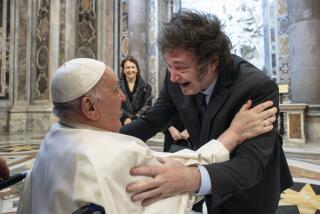Years After Nino’s Death, Miracle Curer’s Cult Thrives
- Share via
ESPINAZO, Mexico — Ana Maria Coronado, in a flowing white robe and red cape, stood before an elaborate homemade altar with her eyes shut tight and her hands clasped together in prayer.
A elderly woman complaining of leg pain asked for help.
“We’ll just get you wooden ones,” joked Coronado in a high, soft voice. She then gave the woman “spiritual injections” and a limpia , or cleansing, by vigorously rubbing her head and body with limes and eggs dipped in scented water.
Coronado is one of hundreds of mediums who claim to go into a trance when the spirit of long-dead Nino Fidencio, said to have been a miracle curer, takes possession of their bodies to heal the sick with a touch and a prayer.
Fidencistas seeking cures regularly visit the dusty hamlet of Espinazo, about 60 miles northwest of Monterrey. But thousands come during festivals in October and March.
This healing cult, an offshoot of folk Catholicism and traditional Mexican folk and herbal medicine, started in the 1920s when Jose Fidencio Constantino Sintora gained a reputation for amazing healing abilities.
Born in 1898, he was called “Nino Fidencio,” or the Boy Fidencio, because of his high voice, lack of facial hair and childlike clothes and personality.
The Nino considered himself a good Catholic who healed with God’s help. Although the church did not approve, it tolerated him, said Fernando Garza Quiroz, author of a book on Fidencismo.
The Nino died at 40 on Oct. 19, 1938, of fever, cirrhosis of the liver or an endocrine imbalance--opinions vary.
With the Nino’s elevation to cult level, the Roman Catholic Church frowns more now than it did when he was alive.
“He did some good things, but in no way can he be considered a saint,” said Father Felipe Jesus Leal Galvan, a spokesman for the Monterrey Archdiocese. “They are always talking about his extraordinary cures, but they never talk about those who died, and there were a lot.”
Prof. William Murray of the University of Monterrey’s medical school, who has studied the phenomenon, said there are probably 20,000 Fidencistas in Mexico and the United States.
More to Read
Sign up for Essential California
The most important California stories and recommendations in your inbox every morning.
You may occasionally receive promotional content from the Los Angeles Times.













